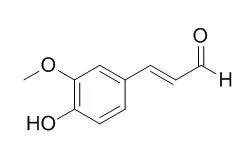| In vitro: |
| Chem Biodivers. 2013 Jul;10(7):1322-7. | | Heat shock factor 1 inducers from the bark of Eucommia ulmoides as cytoprotective agents.[Pubmed: 23847077] |
The barks of Eucommia ulmoides (Eucommiae Cortex, Eucommiaceae) have been used as a traditional medicine in Korea, Japan, and China to treat hypertension, reinforce the muscles and bones, and recover the damaged liver and kidney functions.
METHODS AND RESULTS:
Among these traditional uses, to establish the recovery effects on the damaged organs on the basis of phytochemistry, the barks of E. ulmoides have been investigated to afford three known phenolic compounds, Coniferaldehyde glucoside (1), bartsioside (2), and feretoside (3), which were found in the family Eucommiaceae for the first time. The compounds 1-3 were evaluated for their inducible activities on the heat shock factor 1 (HSF1), and heat shock proteins (HSPs) 27 and 70, along with four compounds, geniposide (4), geniposidic acid (5), pinoresinol diglucoside (6), and liriodendrin (7), which were previously reported from E. ulmoides.
CONCLUSIONS:
Compounds 1-7 increased expression of HSF1 by a factor of 1.214, 1.144, 1.153, 1.114, 1.159, 1.041, and 1.167 at 3 μM, respectively. Coniferaldehyde glucoside (1) showed the most effective increase of HSF1 and induced successive expressions of HSP27 and HSP70 in a dose-dependent manner without cellular cytotoxicity, suggesting a possible application as a HSP inducer to act as cytoprotective agent. | | Food Microbiol. 2008 Feb;25(1):105-12. | | Effect of phenolic aldehydes and flavonoids on growth and inactivation of Oenococcus oeni and Lactobacillus hilgardii.[Pubmed: 17993383 ] | The aim of this work was to investigate the effect of wine phenolic aldehydes, flavonoids and tannins on growth and viability of strains of Oenococcus oeni and Lactobacillus hilgardii.
METHODS AND RESULTS:
Cultures were grown in ethanol-containing MRS/TJ medium supplemented with different concentrations of phenolic aldehydes or flavonoids and monitored spectrophotometrically. The effect of tannins was evaluated by monitoring the progressive inactivation of cells in ethanol-containing phosphate buffer supplemented with grape seed extracts with different molecular weight tannins. Of the phenolic aldehydes tested, sinapaldehyde, Coniferaldehyde, p-hydroxybenzaldehyde, 3,4-dihydroxybenzaldehyde and 3,4,5-trihydroxybenzaldehyde significantly inhibited the growth of O. oeni VF, while vanillin and syringaldehyde had no effect at the concentrations tested. Lact. hilgardii 5 was only inhibited by sinapaldehyde and Coniferaldehyde. Among the flavonoids, quercetin and kaempferol exerted an inhibitory effect especially on O. oeni VF. Myricetin and the flavan-3-ols studied (catechin and epicatechin) did not affect considerably the growth of both strains. Condensed tannins (particularly tetramers and pentamers) were found to strongly affect cell viability, especially in the case of O. oeni VF. In general, this strain was found to be more sensitive than Lact. hilgardii 5 to the phenolic compounds studied.
CONCLUSIONS:
This work contributes to the knowledge of the effect of different phenolic compounds on the activity of wine lactic acid bacteria, which, especially in the case of aldehydes and of different molecular weight fractions of tannins, is very scarce. |
|






 Cell. 2018 Jan 11;172(1-2):249-261.e12. doi: 10.1016/j.cell.2017.12.019.IF=36.216(2019)
Cell. 2018 Jan 11;172(1-2):249-261.e12. doi: 10.1016/j.cell.2017.12.019.IF=36.216(2019) Cell Metab. 2020 Mar 3;31(3):534-548.e5. doi: 10.1016/j.cmet.2020.01.002.IF=22.415(2019)
Cell Metab. 2020 Mar 3;31(3):534-548.e5. doi: 10.1016/j.cmet.2020.01.002.IF=22.415(2019) Mol Cell. 2017 Nov 16;68(4):673-685.e6. doi: 10.1016/j.molcel.2017.10.022.IF=14.548(2019)
Mol Cell. 2017 Nov 16;68(4):673-685.e6. doi: 10.1016/j.molcel.2017.10.022.IF=14.548(2019)